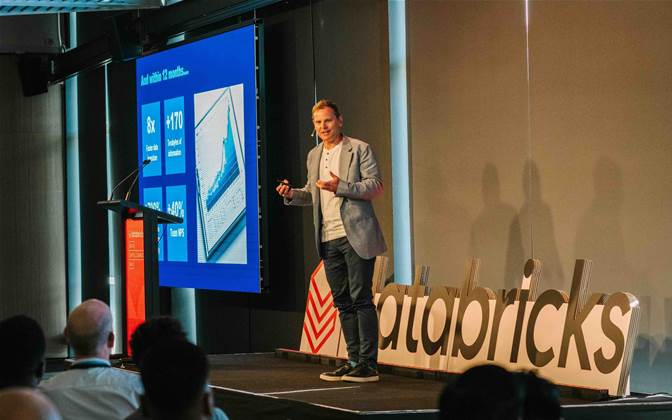Bupa has really established an goal to develop a “digital health twin” for each single consumer that may be utilized to energy preventative and customer-centric discussions and therapy packages.

.Bupa’s Ed Falconer (Image credit standing: Databricks)
.
Chief data police officerEd Falconer knowledgeable a Databricks data data day inMelbourne that the insurance coverage supplier has really stood and optimized an data system over the earlier 2 years to underpin its ‘connected care’ strategy and vision.
“We want to create better experiences for our customers, [where] those experiences will typically turn into preventive and personalised healthcare,” Falconer claimed.
“Ultimately, what we intend to have the power to develop is an digital well being and wellness double for each personal consumer, which isn’t merely backwards wanting but likewise anticipating.
“When we focus on preventative therapy and wishing to applied preventative packages, you plan to forecast issues, problems or issues that our individuals may cope with sooner or later, and afterwards positioned within the therapy packages that point out [those conditions] actually don’t occur.
“What we want to do is create this healthier, happier, long living customer base.”
This will surely not simply revenue customers, but medical professionals too, in response to Falconer.
“Our clinicians want to be able to spend more time talking and finding out better programs to put forward, rather than looking at data and trying to interpret it,” he claimed.
The data system, primarily based upon Databricks, bridges data silos and settles quite a few older data storage services.
The heritage data fashion had really previously been a “limitation” on Bupa’s functionality to “strive for … customer-centricity”, demanding the makeover.
Databricks has really been established as a “modern, safe, secure, single source of truth” for the insurance coverage supplier, caring for role-based accessibility to data and powering data-driven campaigns.
Falconer claimed that it got here to be clear all through the makeover that the agency had not been making fast-enough development.
“The demand within the business and industry [for data] was increasing, and we were just finding ourselves a little bit too slow [and that it was] little bit too complex to do things at a rapid pace,” Falconer claimed.
“One of the key complaints was there’s not much data in the new data platform that we’re building”, which urged some clients to not make the shift.
Falconer claimed that quite a lot of technological and social repairs have been sought, particularly over the earlier yr.
He didn’t enter into the technological repairs, but claimed that just a few of the insurance coverage supplier’s initiatives round “organising for speed” are improved much more data design sources – in his phrases, “More people actually doing the tasks and less people standing around telling people what tasks to do”.
The job group likewise dedicated to much less factors and targeting mattress linen these down.
“There’s temptation to do a lot due to the scale of things that need to get done, but we reduced that down to ‘what are the big things aligned to our strategy that we should be focusing on first to have maximum impact?’.”
Additionally, the job group concerned inside subject specialists (SMEs) way more very carefully to lower data silos, and had some help from Databricks on some assimilations with numerous different methods.
“As a result of those four things, and all of the technical things that we implemented, over a 12 month period we ended up going eight times faster in terms of moving all of the data that we had into the platform, [with] hundreds of terabytes of data flowing through from the old systems into the new systems,” Falconer claimed.
Staff interplay and buy-in is likewise up.
Falconer claimed that Bupa desired methods that sustained personnel to train their “craft” – whether or not that’s scientific, data analytics or an extra approach – which there’s proof the system is aiding personnel and scientific employees to meet these targets.
“It’s about how we help our people to bring their craft and their best selves to work in order to meet our purpose,” he claimed.
The system is likewise at the moment all set to carry “all the predictive and descriptive elements and insights together against an individual customer, in a controlled, safe and secure [way]” to meet the insurance coverage supplier’s extra complete customer-centric goals.
Falconer claimed that “hundreds” of utilization situations for the system had really been acknowledged that supplied this customer-centric goal.
He defined one service-oriented utilization state of affairs, which could make the most of data to determine whether or not an individual is seeing an oral methodology, and in any other case, to press them within the course of 1 run by Bupa.
A 2nd utilization state of affairs, which exhibits as much as mirror the digital well being and wellness double ardour, is “to have predictions of the risk of chronic conditions”, which is likely to be utilized to “move us towards preventative care.”
Falconer likewise noticed an opportunity to make the most of generative AI to sum up data regarding a client in a purposeful means, significantly for scientific goals.
“Sometimes, if you’re collecting all of this information, you just need a summary of it and a recommendation of what you should be pursuing,” he claimed.
“Especially if you’re a clinician with 15 minutes of opportunity to discuss the challenges and the problems that are faced by the patient, how do you streamline it and go quick and make [good] decisions?”



